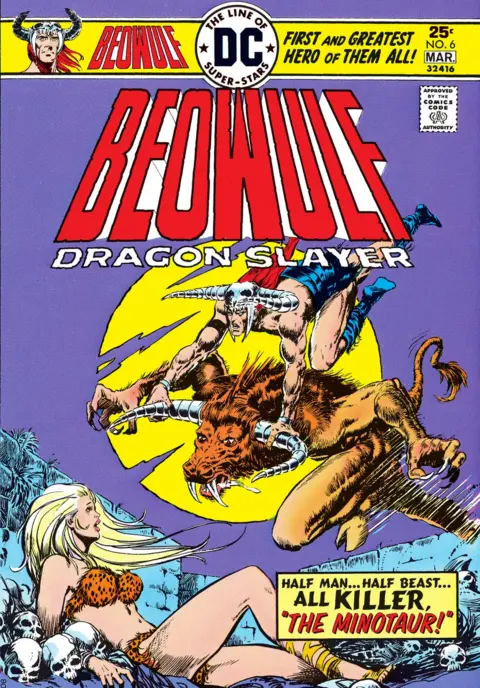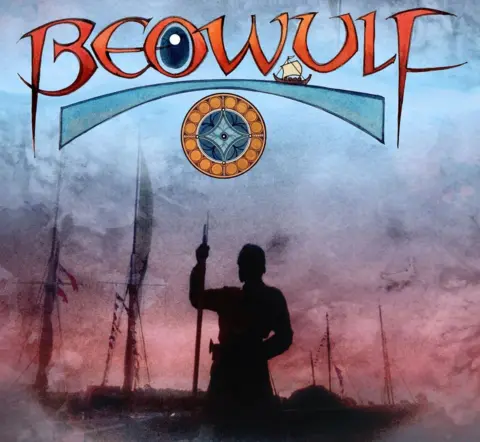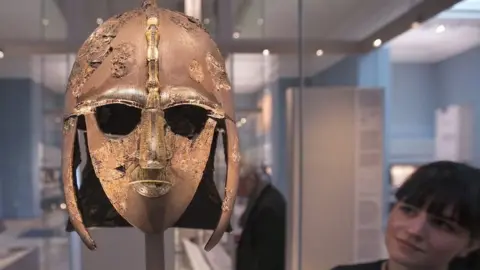Beowulf: The enduring appeal of an Anglo-Saxon 'superhero story'
 Britt Martin
Britt MartinAs the cold sting of winter finally starts to fade, so the literary festival season edges closer. An addition to the line-up this year is a five-day celebration of the legendary saga of Beowulf. How is it that a story written by an unknown author more than 1,000 years ago still captures the imagination?
The eponymous hero of this 3,182-line poem battles fierce monsters, rips off his enemy's arm, fights a fire-breathing dragon and defends a nation.
It could be the plot of Hollywood's latest blockbuster movie.
But this is the story of Beowulf, a poem once told in timber-framed barns in Anglo-Saxon England, to the raucous noise of the mead-swilling crowd.
Described by historian and broadcaster Michael Wood as "being at the very root of English literature", the author and the exact date of composition remain a mystery.
There is only one surviving manuscript, and even that was nearly destroyed in an 18th Century library fire.
 Alamy
AlamySome 1,300 years on from when most historians believe it was written, Beowulf continues to be shared, adapted and revised, whether on screen, in print or in song.
JRR Tolkien, who was a noted expert on the poem, is widely thought to have taken inspiration from Beowulf for his Lord of the Rings trilogy.
According to Prof Andrew Burn, from University College London (UCL), the roots of popular medieval-themed video games and TV shows can also be found in this epic saga.
"Look at Lord of the Rings, Dungeons & Dragons, Game of Thrones, any of those big TV franchises, and you realise what the perennial source of interest there is in the same themes: bravery, mortality, power struggles, social hierarchy," he says.
 British Library
British LibraryTolkien, who was a professor of Anglo-Saxon English, completed his own translation of Beowulf in 1926.
Irish poet Seamus Heaney's 1999 translation became a bestseller, and children's author Michael Morpurgo has retold the story for younger readers.
There have also been comic books, films, TV series and documentaries.
 HBO/SKY
HBO/SKYExplaining the enduring allure of the poem, Mr Wood says: "Before there was Shakespeare, there was this. It's all great stuff: you have a monster, a hero, the final battle with the dragon.
"It's a great story; people have recreated it and remade it.
"It's been reworked because it's got that power to it. There's a tragic dimension; people really respond to that.
"There are only a few great stories, after all. We always come back to the same themes: monsters, heroes - and Beowulf has those."
 DC Entertainment
DC Entertainment Beowulf tells the story of how the monster Grendel terrorises a Danish stronghold until the Swedish Beowulf arrives.
The young Beowulf kills Grendel, ripping off his arm in the process, and then slays Grendel's avenging mother.
Beowulf becomes King of the Geats and reigns for 50 years - until he challenges a dragon that ravages his kingdom.
Both Beowulf and the dragon die in this final battle.
 Getty Images
Getty ImagesAuthor and poet Kevin Crossley-Holland, who has translated the poem into modern English, says it is likely to have been written in about 650.
There is only one surviving copy from the whole of the medieval period, the manuscript now known as British Library Cotton MS Vitellius A XV, which will go on display in the library's Anglo-Saxon Kingdoms exhibition in the autumn.
Mr Crossley-Holland - for whom the monsters are like "humans gone wrong" and "terrifying because of that" - says that the poem has a very deliberate pace.
"It's bit like an old-fashioned dance step; like a quickstep, it advances quite slowly, one step forward, one step sideways.
"It doesn't hurry, I suspect because people were coughing and have got sore throats, and groaning because they had arthritis.
"And that slow step forward, step sideways, enabled everyone to keep up," he says.
He believes it was probably told in three sessions, and there "must've been laughter and filling of mead beakers", during what would have been a "social occasion".
 Susie Hammond
Susie HammondBeowulf isn't just significant in English literary history - it is set in Denmark and was actually first translated from the Anglo-Saxon into Danish.
As Prof Burn says, the Danes "see it as their poem as well".
The professor of English, media and drama was involved in a 2015 project, Playing Beowulf, as part of which workshops were held, challenging students of all ages to transform the story of Beowulf into a video game.
Digital Arts Research Education - a partnership between organisations including University College London, the British Library and Game City - worked with five schools in London, primary school pupils in Nottingham, a drama group in Sydney, Australia, and PhD students at UCL.

You might also be interested in:

As Prof Burn points out, Beowulf lends itself readily to modern interpretations.
"You can read the poem as coding; the language is formulaic in its narrative," he says.
He argues that Beowulf has "general appeal" due to its themes of "perennial importance".
"It's really another superhero story."
 Rachel Cade
Rachel CadeThe festival is being staged in the Suffolk town of Woodbridge, and Mr Crossley-Holland is among those who believe Beowulf might have been written in the area.
The town is close to the world famous Anglo-Saxon burial site of Sutton Hoo, where a ship filled with treasures was unearthed in 1939.
Believed to be the final resting place of the 7th Century King Raedwald of East Anglia, it is one of the most spectacular and important discoveries in British archaeology.
 Beowulf Festival
Beowulf FestivalWoodbridge's outgoing mayor Clare Perkins sees the festival as her parting gift.
"So many people don't realise the basis of so many epic tales, games and films comes back to Beowulf," she says. "It's the forerunner of George and the Dragon, of Lord of the Rings.
"There's so much energy here in Woodbridge; you can feel that energy and, if you are imaginative, you can imagine all the warriors coming across the river."
 Getty Images
Getty Images West Suffolk Council
West Suffolk CouncilAnd so even though Beowulf might have been written more than a millennium ago, in the words of Mr Wood, it "still speaks to us".
For Mr Crossley-Holland, the poem has lasted the course because of its "huge appetite for life".
"We all know time has us beat, but we're all interested in making the most of who we are," he says.
"On the whole, life's to be relished, lived to the full, laughed with and at."
Beowulf Festival runs from Thursday 3 May to Monday 7 May
